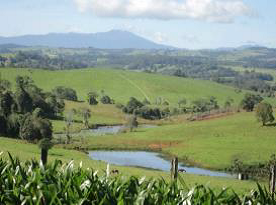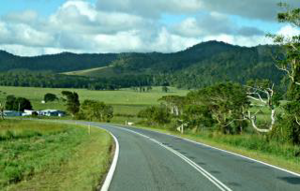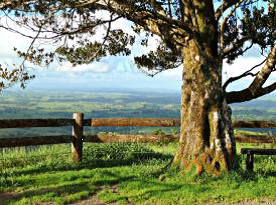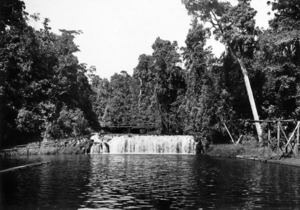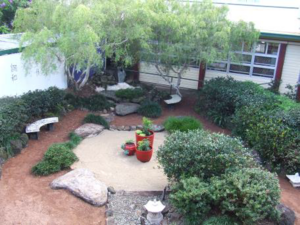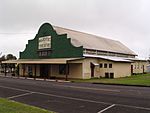Malanda, Queensland facts for kids
Quick facts for kids MalandaQueensland |
|||||||||||||||
|---|---|---|---|---|---|---|---|---|---|---|---|---|---|---|---|
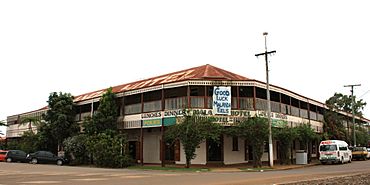
Malanda Hotel
|
|||||||||||||||
| Population | 2,000 (2021 census) | ||||||||||||||
| • Density | 45/km2 (120/sq mi) | ||||||||||||||
| Established | 1908 | ||||||||||||||
| Postcode(s) | 4885 | ||||||||||||||
| Elevation | 732 m (2,402 ft) | ||||||||||||||
| Area | 44.7 km2 (17.3 sq mi) | ||||||||||||||
| Time zone | AEST (UTC+10:00) | ||||||||||||||
| Location |
|
||||||||||||||
| LGA(s) | Tablelands Region | ||||||||||||||
| State electorate(s) | Hill | ||||||||||||||
| Federal Division(s) | Kennedy | ||||||||||||||
|
|||||||||||||||
Malanda is a rural town and area in the Tablelands Region of Queensland, Australia. In 2021, about 2,000 people lived there. The town is known for its farms, especially dairy products like milk, and for tourism.
Contents
Exploring Malanda's Location
Malanda is located on the Atherton Tableland in Far North Queensland. It is about 85 kilometres (53 miles) from Cairns and sits 732 metres (2,402 feet) above sea level. The town is found near the Malanda Falls on the North Johnstone River.
The Malanda Falls are a beautiful waterfall about 4 metres (13 feet) high. They were formed by ancient lava flows from the Malanda Shield Volcano. Many people enjoy swimming at the bottom of the falls. Some say the name 'Malanda' comes from an Aboriginal word meaning 'waterfalls'.
The town is connected by roads like the Malanda–Atherton Road and the Millaa Millaa–Malanda Road.
Malanda's Past: A Brief History
The land where Malanda now stands was originally part of the Ngajanji people's territory. The name Malanda is thought to be an Aboriginal word for the Upper Johnstone River. It might mean 'little stream with big stones' or 'running rivers'.
Malanda began to grow in the early 1900s. This happened after tin and copper were found in Herberton. Many miners and engineers moved through the area.
The Railway Arrives
In 1886, there were plans to build a railway to the area. It was a difficult project, but by 1911, the railway finally reached Malanda. This helped the town grow, but the line closed in 1964.
The Dairy Industry Begins
In 1908, James English and James Emerson moved to Malanda. They saw that the area was perfect for dairy farming. English brought cattle from New South Wales. Emerson brought a large herd of 1,026 cattle, but only 560 survived the long 16-month journey.
Despite this tough start, the dairy industry thrived. By 1919, Malanda had its own butter factory. This factory later joined with another in Millaa Millaa in 1973.
Other Early Developments
In 1910, John Prince started a sawmill in Malanda. This mill provided the wood for the Malanda Hotel, which was built in 1911. The Malanda Post Office opened in 1912. Malanda State School welcomed its first students on August 4, 1913. The first Malanda Show, a local fair, took place in 1916.
Malanda's Population Over Time
The number of people living in Malanda has changed over the years.
- In 2006, the town had 1,009 people.
- In 2011, the area of Malanda had 2,052 people.
- In 2016, the population was 1,985 people.
- In 2021, the population was 2,000 people.
Places of Historical Importance
Malanda has several places that are listed for their historical importance. These are called heritage-listed sites:
- Majestic Picture Theatre at 1 Eacham Place.
- Malanda Falls Swimming Pool in Malanda Falls Park.
- St James Catholic Church on Monash Avenue.
Malanda's Economy: Dairy and More
Malanda is well-known for producing milk and cheese. Malanda milk used to be sold very far away, even in the Northern Territory and as far north as Weipa. People used to say Malanda was the 'headquarters for one of the largest and longest milk runs in the world'.
Today, Malanda Milk is part of Dairy Farmers. Its milk is sold from Mackay in the south to Darwin in the north.
Education in Malanda
Malanda has schools for students of all ages.
- Malanda State School is a government primary school for students from Prep to Year 6. It is located at 24 Mary Street. In 2018, about 380 students attended the school. It also has a special education program.
- Malanda State High School is a government secondary school for students from Year 7 to Year 12. It is on Memorial Drive. In 2018, about 418 students were enrolled there. This school also offers a special education program.
Community Facilities and Services
- The Malanda Library is run by the Tablelands Regional Council. It is located at 31 James Street and is open from Tuesday to Saturday.
- The Queensland Country Women's Association (QCWA) has a branch in Malanda. They meet at the QCWA Hall on 3 Elizabeth Street.
- St James' Catholic Church is located at 7 Monash Avenue.
Fun Things to See and Do
Malanda offers many attractions for visitors and locals alike.
Malanda Falls Conservation Park
The Malanda Falls Conservation Park is right across from the Malanda Falls. You can take a short walk through the beautiful rainforest here. It's a great place to see many different kinds of rainforest trees.
Peeramon Hotel
About 6 kilometres (4 miles) east of Malanda is the Peeramon Hotel. This historic pub is the only building left of what was once a busy town. The publican has a cool collection of old telephones!
Malanda Art Trail
The Malanda Art Trail starts at the town library. It features nine colourful artworks that tell the story of Malanda's history. These mosaics show things like the original inhabitants, early settlers, transport, and the dairy industry. Each mosaic even has a hidden blue butterfly!
Swimming with Platypus
You can actually swim with platypus at the bottom of Malanda Falls! The North Johnstone River is safe for swimming because there are no crocodiles. You might even spot Tree-kangaroos crossing the road near the falls.
Majestic Theatre
The Majestic Theatre is said to be the oldest movie theatre in Australia that is still running. It opened on December 14, 1929. It's a unique place to catch a movie!
Malanda Hotel
The Malanda Hotel is famous for its grand ballroom and staircase. It is believed to be the largest wooden building in Australia.
Historical Resource Centre
The Historical Resource Centre is on Elizabeth Street. It's where the Eacham Historical Society keeps old photos and documents about the history of North Queensland. Students and the public can use the library here to learn about the area's past.
Notable People from Malanda
- Charles English: A former member of the Queensland Parliament.
- Jack Mundey: A well-known trade unionist and conservationist.
- Shane Stefanutto: A former professional football (soccer) player.



